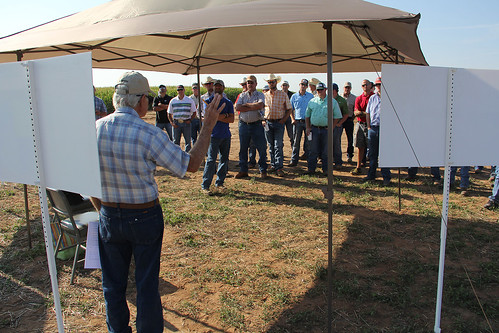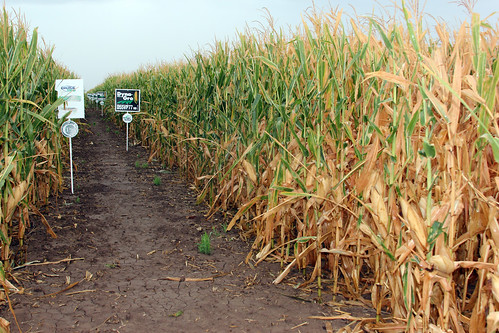
Project Manager Leon New discusses the progress of the 3, 4, 5 demonstration project at a 2015 district producer field day.
In the Ogallala Aquifer region, each drop of water counts. A group of forward-thinking farmers in Texas are finding innovative ways to irrigate their crops to use water more efficiently.
These farmers are working with the North Plains Groundwater Conservation District in the panhandle to study use of water from the aquifer. The Ogallala is the nation’s largest aquifer and is being depreciated by water withdrawals at an unsustainable rate.
The district received assistance from USDA’s Natural Resources Conservation Service (NRCS), both through the Ogallala Aquifer Initiative and a Conservation Innovation Grant. The grant programs help conservation districts and other organizations test innovative approaches and technologies.
In the Conservation District’s 3, 4, 5 Project farmers irrigated corn at different rates to evaluate whether lower irrigation rates could still produce profitable yields. The producers irrigated at three, four and five gallons per minute depending on the field.
“The purpose of this demonstration is to see if we can produce similar corn yields with less irrigation and supplemental rainfall,” said Leon New, the district’s project manager. “We have yield differences in the fields and we are anxious to learn what they are in relation to measured water.”
The results showed that at three gallons per minute: Yields averaged 226 bushels per acre with a net return of $463; at four gallons per minute: Yields averaged 238 bushels per acre with a net return of $483; and at five gallons per minute: Yields averaged 255 bushels per acre with a net return of $513.
While the net returns were higher as more water was pumped, farmers grew more corn per gallon when they irrigated at lower rates. And with less water, farmers still produced profitable yields.
“I am impressed by the trial results the district has released for the first year of the 3, 4, 5 Project,” said Mike Caldwell, NRCS resource team leader in Dumas, Texas. “It’s interesting to know that the crops with less water, applied at three gallons per minute per acre had the deepest root systems. This shows that the crops roots were using water in the entire soil profile with no water waste. It’s important to know this at a time when water levels are continuing to decline.”
With NRCS help, the district is evaluating water use in the region. The district is also sharing this information with others. The district has held field days on some of the farms participating in the project, giving other farmers a chance to see how corn plants were responding to the different irrigation rates.
Learn more about NRCS’ Conservation Innovation Grants program and Ogallala Aquifer Initiativeonline. For more on technical and financial assistance available through conservation programs, visitwww.nrcs.usda.gov/GetStarted.
NOTE: For an interactive look at USDA’s work in conservation and forestry over the course of this Administration, visit http://medium.com/usda-results.

The 3, 4, 5 demonstration project is equipped with seven center pivot sprinkler irrigation systems irrigating 15 fields.
No comments:
Post a Comment
Note: Only a member of this blog may post a comment.